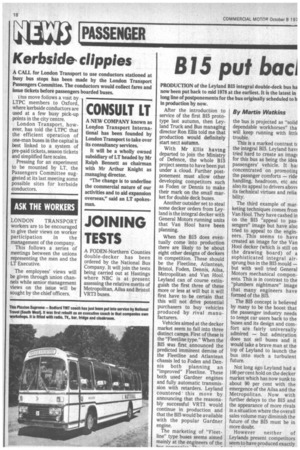815 put bacI PRODUCTION of the Leyland 815 integral double-deck
Page 20

If you've noticed an error in this article please click here to report it so we can fix it.
bus ha now been put back to mid 1978 at the earliest. It is the latest in long line of postponements for the bus originally scheduled to b in production by now.
By Martin Watkins After the introduction to service of the first B15 prototype last autumn, then Leyland Truck and Bus managing director Ron Ellis told me that production would definitely start ne;:t autumn.
With Mr Ellis having departed to join the Ministry of Defence, the whole B15 project seems to have been put under a cloud. Further postponement must allow other developing competitors such as Foden or Dennis to make their mark on the small market for double deck buses.
Another outsider set to steal some decker orders from Leyland is the integral decker with General Motors running units that Van Hool have been planning.
When the B15 does eventually come into production there are likely to be about eight other designs of deckers in competition. These should be the Fleetline, Atlantean, Bristol, Foden, Dennis, Ailsa, Metropolitan and Van Hool. Leyland can of course extinguish the first three of these more or less at will but it will first have to be certain that this will not drive potential purchasers to buy vehicles produced by rival manufacturers.
Vehicles aimed at the decker market seem to fall into three distinct camps. First of these is the "Fleetline type." When the BI5 was first announced the predicted imminent demise of the Fleetline and Atlantean chassis led to Foden and Dennis both planning an "improved" Fleetline. These both used Gardner engines and fully automatic transmission with retarders. Leyland countered ' this move by announcing that the reasonably successful VRT3 would continue in production and that the BI5 would be available with the popular Gardner engine.
The marketing of "Fleetline" type buses seems aimed mainly at the engineers of the the bus is projected as "solid dependable workhorses" tha will keep running with litt1( trouble.
This is a marked contrast tc the integral BI5. Leyland hav( tried hard to create an imag( for this bus as being the idea passengers' vehicle. It ha: concentrated on promotinf the passnger comforts — ride handling, headroom, etc anc also its appeal to drivers abov( its technical virtues and relia, bility.
The third example of marketing techniques comes from Van Hool. They have cashed in on the BI5 "appeal to passengers" image but have also tried to appeal to the engineers. This seems to have created an image for the Van Hool decker (which is still on the drawing board) of a sophisticated integral airsprung bus in the BI5 mould — but with well tried General Motors mechanical components. This is in contrast to the "plumbers nightmare" image that many engineers have formed of the BI5.
The BI5 concept is believed by many to be the boost that the passenger industry needs to tempt car users back to the buses and its design and comfort are fairly universally admired — but admiration doee not sell buses and it would take a brave man at the top of Leyland to launch the bus into such a turbulent future.
Not long ago Leyland had a 100 per cent hold on the decker market which has now sunk to about 90 per cent with the emergence of the Ailsa and the Metropolitan. Now with further delays to the B15 and the appearance of more rivals in a situation where the overall sales volume may diminish the future of the BI5 must be in more doubt.
However neither of Leylands present competitors seem to have produced exactly




















































































